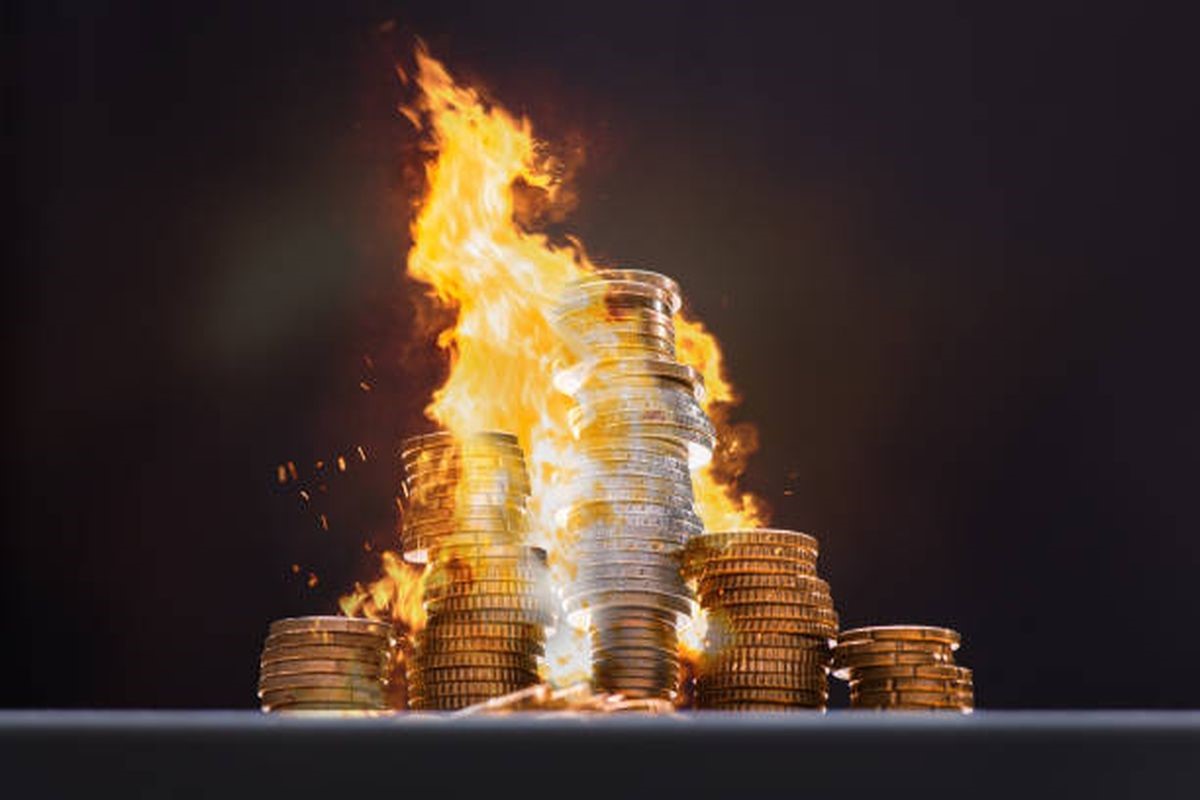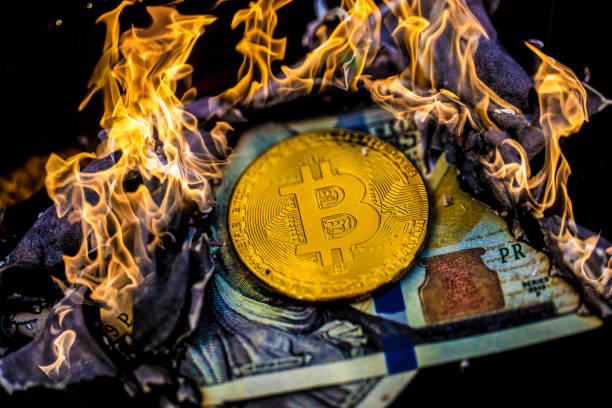What is Proof of Burn? Proof-of-Burn (PoB) is a consensus algorithm that utilizes the burning of coins to create significant value. By description, Proof-of-Burn is a strategy of securing crypto networks via the destruction of coins. To develop a new block and receive the associated rewards, the miner needs to submit a Proof-of-Burn transaction.
Such transactions send a particular number of coins to an address that will never be used again. These coins are then said to be ‘burned’ or destroyed. This strategy is a real-world investment to become a miner. It is impossible to create a new block by burning random coins.
To participate in such networks, you will need to sacrifice something quite valuable. It helps in guaranteeing that just the serious players participate and ensures that the stability of the network is maintained.
CounterParty (XCP) was the first to implement Proof-of-Burn in January 2014 to help in securing their blockchain. Here is how it operates: XCP had a total of 663 coins before implementing PoB. Later, there were still 663 coins in circulation. However, no new coins were ever created. The blocks were mined after every two minutes, with every block awarding five new coins to the miner that discovered it.
Since all these activities happened onto Bitcoin (BTC), XCP miners also got all transaction fees for each trade that they executed on the CounterParty platform.
There are major differences that exist between Proof-of-Work (PoW) mining and Proof-of-Burn (PoB). In the case of PoW mining, the total number of coins that the miner can create is unlimited. Provided that they have adequate computing power, they may continue creating new blocks and earning rewards.
Related: Top Seven Reasons Why Bitcoin is Popular Today
In the case of Proof-of-Burn (PoB), the total number of coins in circulation is fixed. It means that there is a finite amount of rewards available for the miners. That finite nature prevents inflation in the network. Another notable difference is that the process of mining is quite slow in the PoB. Miners first need to find the unused address and then submit their proof of burn transaction to create a new block.
All newly mined coins are sent into an unspendable address for up to 512 blocks before they become spendable once more. The spending procedure needs sending a special type of transaction known as an OP_RETURN transaction. This transaction also consists of the block header’s hash. After this transaction is sent, some of the coins are automatically burned and a new block emerges.
After their initial coin offering (ICO), they activated a Proof-of-Burn strategy where the approved users may burn their PTS tokens in exchange for a specific amount of Counterparty (XCP). It helped in the distribution of XCP evenly among all the participants who wanted it at the time.
Burning the coins makes them rare, which normally pushes the prices higher. Furthermore, in case you want to get in at the ICO stage for any new Proof-of-Stake token, burning some altcoins or bitcoin might increase demand while concurrently lowering supply. Experts term it as the bootstrapping effect.
How Proof-of-Burn Operates
Burning coins involves sending coins to an unspendable address where they are effectively destroyed. The burning process is known as ‘destroying’ coins but these coins are not being burned since their data still exists on the network. Instead, burning can be described as an irreversible public action where some of the coins are sent to a place where they are no longer accessible for spending.
Proof-of-Burn is also described as the locking of some amount of crypto by sending them to an unspendable wallet in exchange for the tokens active on other blockchains. The locked cryptos are effectively destroyed since they can no longer be useful for anything except exchanging for new tokens.
The PoB concept creates a “negative mining” incentive. Hence, to create new tokens, one has to destroy some of the existing ones. It makes it more challenging to develop new tokens, as it needs investing real resources. Burning protects the value of the new tokens and also prevents them from getting devalued by excessive inflation.
In many cases, Proof-of-Burn is used in blockchain projects that issue their tokens because it offers an additional layer of security against devaluation and inflation. Moreover, it encourages users to hold onto their tokens instead of selling them since they can just be redeemed by destroying the other cryptos.
In a normal PoB scheme, a public key is set up upon which satoshis are sent. Through the public key, the user can check how much “virtual Bitcoin” has already been burned at any specific time by anyone realizing that the public key generates the data. The more the satoshis sent to the key, the more “Proof-of-Burn” it represents.
Proof-of-Burn versus Proof-of-Work versus Proof-of-Stake
Several types of proofs can be used to authenticate transactions on a blockchain. The three most popular include Proof-of-Work (PoW), Proof-of-Burn (PoB), and Proof-of-Stake (PoS).
In the Proof-of-Burn, new coins are developed by burning a particular amount of an existing coin. The process happens when the users send coins to a specific address that can only burn them. After these coins have been burned, they are destroyed to ensure that they will never be used again.
New coins are created by taking all the burned coins and dividing their number by the total coins in circulation at a given time.
PoW is described as a strategy where the new coins are formed by solving a complex mathematical problem. The first miner who solves a given problem gets rewarded with a stipulated number of coins. This method is used to prevent users from creating fake coins by solving problems quicker than everybody else.
PoS involves a system where some new coins are created by holding some amount of an existing coin. That is achieved by sending these coins to a particular address that is allowed to stake them. After these coins are staked, they are locked up and can never be used again. New coins are then developed by taking the total amount of staked coins and dividing it by the cumulative amount of coins that remain in circulation.
Related: Chia Network And The Proof Of Space Movement
Examples Of Proof-of-Burn
Some companies insist on implementing the PoB strategy and allege that it can be customized. One virtual currency network that uses PoB, Slimcoin, provides the miners with the option of burning coins to access the next blocks for at least a year.
Normally, Slimcoin’s PoB strategy integrates three algorithms: PoS, PoW, and the normal PoB concept. The burning process is done using PoW. Chances of mining increase with the burning of more coins. Eventually, all participants in the ecosystem follow the PoB concept.
Benefits Of PoB
Many benefits come with using Proof-of-Burn as a consensus mechanism. Some of these benefits include:
- Reduced rate of energy consumption – one of the major criticisms of Proof-of-Work is that it needs a lot of energy to work efficiently. On the other hand, Proof-of-Burn does not have this challenge, which makes it more environmentally friendly. The ‘digging’ process in PoW consumes lots of energy that is then wasted and becomes unproductive.
- Censorship resistance and increased security – PoB is secure than other mechanisms since it is highly challenging to dupe the system or attack it. Moreover, it is quite challenging to limit transactions or block the nodes that participate in a given network that uses PoB. Thus, it is a resilient and perfect option for businesses and people who want to guarantee that their data is safe and can never be censored.
- Fair distribution of currency – most alternative currencies see their early adopters own huge amounts of coins which eventually results in unfairness and instability of the network. Proof-of-Burn assists in preventing such occurrences by guaranteeing that the distribution of new coins is done to users willing to invest their computing power and resources into the growth of the network.
- No centralization challenges – in most of the other consensus mechanisms, miners become highly influential over the network since they control lots of hashing power. These powers sometimes become so much that a small group can 51% attack the network, censor transactions, and change many of the rules that authenticate new blocks. That occurrence is not possible with proof-of-burn since the consensus mechanism needs no miners to operate effectively.
- Low barrier to entry – Proof-of-Burn does not need expensive hardware or advanced skills to participate in it. The only thing that is necessary is computing power. Thus, people can easily get started whenever the alternative coins are still in their early stages of development.
Drawbacks Of PoB
Some shortcomings come with the Proof-of-Burn consensus mechanism. They include:
- This consensus goes against the decentralized nature of cryptos – the main reason cryptos are appealing to most investors is decentralization. No single authority controls the digital assets. But, Proof-of-Burn goes against all that by controlling the people that hold the most tokens and coins.
- A huge initial investment – PoB needs a huge initial investment to participate. Since users need to burn coins, the only other available option is to buy these coins from exchanges. Thus, you may need thousands and even millions of dollars to get started with the Proof-of-Burn mechanism.
- Risk of hoarding – another possible challenge is that people may use PoB to hoard coins. That eventually limits the circulating supply and may increase in value. While it may be beneficial for the people that hold these coins, it is not great for the general health of the involved currency.
- Risk of speculation – a possible problem with Proof-of-Burn is that it may be used for speculation. People may acquire coins and then wait until they get a large supply before using these coins to create blocks. That scenario gives them considerable control over the network and may eventually result in instability.
Related: ConsenSys Project Launches ‘Proof-of-Use’ Network to Discourage Speculation
- Attacking the other currencies – PoB might attack other currencies meaning that a person may purchase a huge amount of a specific coin and then use it to create blocks. They then dump these coins on the open market resulting in the devaluation of the currency, which may prove to be harmful to the network.
The Bottom Line
The idea behind the Proof-of-Burn concept is that it forms a rarity for the new tokens, in turn, drives up demand. Its most notable benefit is that it does not need investment in expensive mining hardware to secure the network or distribute coins.











